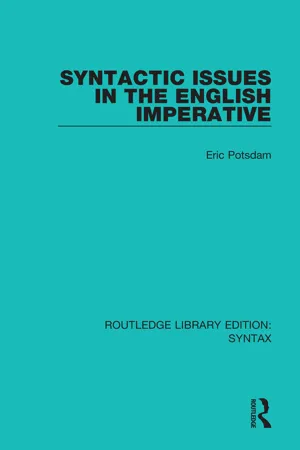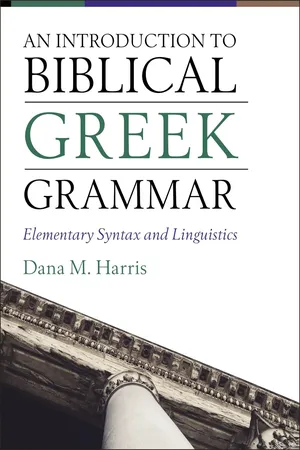Imperative Verbs
Imperative verbs are used to give commands, instructions, or requests. They are typically in the base form of the verb and are directed at the listener to perform a specific action. Imperative verbs are a key component of language for conveying directives and are commonly used in everyday communication.
3 Key excerpts on "Imperative Verbs"
- eBook - ePub
- Eric Potsdam(Author)
- 2017(Publication Date)
- Routledge(Publisher)
...Under a semantic characterization, any construction with the relevant illocutionary force or pragmatic effect may be classified as an imperative, irrespective of its form. Such a description is fundamentally one based on linguistic use and it defines an imperative as a SPEECH ACT TYPE (see the philosophical literature including Austin 1962 and Searle 1969). For example, such an approach potentially labels all of the examples in (1) as imperatives because they all have approximately the same force in a certain situation. I will refer to this speech act type as DIRECTIVE but will not attempt to explicate it (but see chapter 3, section 4 as well as Katz and Postal 1964, Broadie 1972, Stockwell et. al. 1973, Downes 1977, Schmerling 1982, Davies 1986a, and Hamblin 1987). (1) a. Close the window! b. You should close the window! c. Will you close the window, please? d. The window ought to be closed, John. While such a classification is useful in describing language's communicative potential and actual use, it does not make any claims about the syntactic structure of such sentences. Typically, however, there is one particular sentence form which is considered the canonical syntactic realization of a given semantic clause type and this allows us to relate a speech act type to the syntax. I will define an IMPERATIVE to be the syntactic sentence form which is the canonical realization of a directive speech act type. In addition to being unified by a canonical use, imperatives also share core syntactic or morphological properties. (2) is a set of criteria for the English imperative, adapted from Davies 1986a:7, which I will use to further characterize the English imperative clause type. Under this view, the imperative is a SYNTACTIC CLAUSE TYPE. See Davies 1986a; chapter 1 for considerable discussion. (2) Characteristics of the English Imperative Clause Type a lack of tense inflection b...
- eBook - ePub
An Introduction to Biblical Greek Grammar
Elementary Syntax and Linguistics
- Dana M. Harris(Author)
- 2020(Publication Date)
- Zondervan Academic(Publisher)
...chapter TWENTY-TWO THE IMPERATIVE: Forms and Functions; More Pronouns OBJECTIVES AND OVERVIEW Chapter 22 introduces the following linguistic concepts, morphemes, and paradigms: • imperative personal endings • present active and middle imperative paradigms • aorist active, middle, and passive imperative paradigms • forms of imperatives for contract verbs • imperative paradigm of εἰμί • functions of the imperative: command, prohibition • translation of third-person imperatives • first-, second-, and third-person reflexive-pronoun paradigms • reciprocal-pronoun paradigm THE IMPERATIVE: FORMS AND FUNCTIONS So far, we have looked at two finite moods, the indicative and the subjunctive. In this chapter we learn a third finite mood, the imperative. The indicative mood makes an assertion or statement. The subjunctive mood is the mood of probability or potentiality. The imperative mood is used to communicate a command. It is the mood of intention and involves volition; it is the attempt to direct someone’s actions. As with the subjunctive mood, the primary opposition in the imperative mood is between the present tense stem and the aorist tense stem. 1 Imperatives only occur in direct discourse and never in the parts of narrative that record events that took place (they do, of course, occur in the recorded speeches within those narratives). Moreover, imperatives only occur in main clauses. The Forms of the Imperative Imperative forms only occur in the second and third person. As we noted previously, there is a functional overlap between the subjunctive and the imperative, which is summarized as follows: Command 1st person hortatory subjunctive 2nd person imperative 3rd person imperative The present and aorist tense stems are used to build the imperative. Additionally, there are different sets of endings that are used with the imperative, which need to be memorized. These distinctive endings are the biggest formal clue for recognizing the imperative...
- eBook - ePub
- Goold Brown(Author)
- 2004(Publication Date)
- Perlego(Publisher)
...It is that brief form of the verb, by which we directly urge upon others our claims and wishes. But the nature of this urging varies according to the relation of the parties. We command inferiors; exhort equals; entreat superiors; permit whom we will;—and all by this same imperative form of the verb. In answer to a request, the imperative implies nothing more than permission. The will of a superior may also be urged imperatively by the indicative, future. This form is particularly common in solemn prohibitions; as, "Thou shalt not kill. * * * Thou shalt not steal."— Exodus, xx, 13 and 15. Of the ten commandments, eight are negative, and all these are indicative in form. The other two are in the imperative mood: " Remember the sabbath day to keep it holy. Honour thy father and thy mother."— Ib. But the imperative form may also be negative: as, " Touch not; taste not; handle not."— Colossians, ii, 21. TENSES. Tenses are those modifications of the verb, which distinguish time. There are six tenses; the Present, the Imperfect, the Perfect, the Pluperfect, the First-future, and the Second-future. The Present tense is that which expresses what now exists, or is taking place: as, "I hear a noise; somebody is coming." The Imperfect tense is that which expresses what took place, or was occurring, in time fully past: as, "I saw him yesterday, and hailed him as he was passing." The Perfect tense is that which expresses what has taken place, within some period of time not yet fully past: as, "I have seen him to-day; something must have detained him." The Pluperfect tense is that which expresses what had taken place, at some past time mentioned: as, "I had seen him, when I met you." The First-future. tense is that which expresses what will take place hereafter: as, "I shall see him again, and I will inform him." The Second-future tense is that which expresses what will have taken place, at some future time mentioned: as, "I shall have seen him by tomorrow noon." OBSERVATIONS. OBS...


